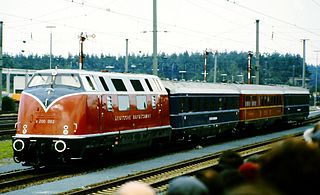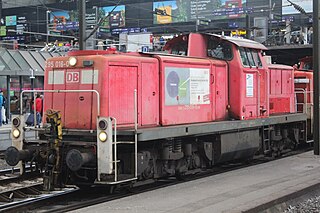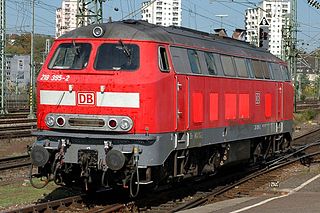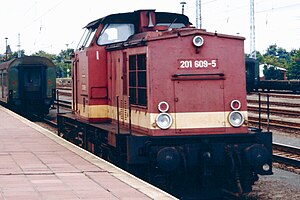
Alstom Traxx is a modular product platform of mainline diesel-electric and electric locomotives. It was produced originally by Bombardier Transportation and later Alstom, and was built in both freight and passenger variants. The first version was a dual-voltage AC locomotive built for German railways from the year 2000. Later types included DC versions, as well as quadruple-voltage machines, able to operate on most European electrification schemes: 1.5/3.0 kV DC and 15/25 kV AC. The family was expanded in 2006 to include diesel-powered versions. Elements common to all variants include steel bodyshells, two bogies with two powered axles each, three-phase asynchronous induction motors, cooling exhausts on the roof edges, and wheel disc brakes.

DB Class V 200 was the first series production diesel-hydraulic express locomotive of the German Deutsche Bundesbahn and – as Am 4/4 – of the SBB-CFF-FFS in Switzerland.

The DR Class 243 is a universal electric locomotive of the Deutsche Reichsbahn which is used for general rail service. Deutsche Bahn lists the locomotive as Class 143. The locomotives of class 143/243 still belong to the most successful class of German electric locomotives.

German Kleinlokomotiven like the DRG Kö II were developed as locomotives with a low weight and driving power for light shunting duties. There were two classes, based on engine power. The Class II were engines which developed more than 40 HP.

The DR Class 65.10 was a class of 2-8-4 passenger train tank engine operated by the East German Deutsche Reichsbahn (DR) for heavy suburban and commuter services.

The steam locomotives of DR Class 99.77–79 were ordered by the Deutsche Reichsbahn in East Germany after the Second World War. They were narrow gauge locomotives with a 750 mm rail gauge and were built for the narrow gauge lines in Saxony. The locomotives were largely identical to the DRG Class 99.73–76 standard locomotives (Einheitslokomotiven) built in the 1930s. To differentiate them from their predecessors they were described as Neubaulokomotiven or newly designed engines.

These DB Class V 100 diesel locomotives were produced in the late 1950s by the Deutsche Bundesbahn for non-electrified branch lines as a replacement for steam locomotives. The V 100 class was built in three different variants.

The DB Class 215 is a 4 axle diesel locomotive of the V 160 type. They were built for the German Federal Railways for medium-weight passenger and freight service on secondary and primary routes, and later passed to the Deutsche Bahn AG.

The DB Class 218 are a class of 4-axle, diesel-hydraulic locomotives acquired by the Deutsche Bundesbahn for use on main and secondary lines for both passenger and freight trains.

The DB Class V 60 is a German diesel locomotive operated by the Deutsche Bundesbahn (DB) and later, the Deutsche Bahn AG, which is used particularly for shunting duties, but also for hauling light goods trains. Seventeen locomotives were bought used by the Norwegian State Railways and designated NSB Di 5. Also the Yugoslav Railways bought used units, and designated them JŽ 734; they were subsequently designated Series 2133 by the Croatian Railways.

The DB Class V90 locomotive is a German diesel-hydraulic locomotive for shunting and freight hauling.

A Kleinlokomotive or Kleinlok is a German locomotive of small size and low power for light shunting duties at railway stations and on industrial railways. Most are powered by diesel engines, but Kleinloks with steam, petrol, or electric engines were also produced.

The DB Class 240 are a class of Co′Co′ diesel-electric locomotives which were produced in the 1980s by MaK in collaboration with Krupp and ABB as DE 1024 as prototypes/technology demonstrators for a possible future order from the Deutsche Bundesbahn.

The DR 130 family of locomotives comprises the DR Class 130, DR Class 131, DR Class 132 and DR Class 142, in USSR locomotive called TE109 and TE129.

The DB V 160 locomotive family comprises several classes of closely related 4-axle diesel-hydraulic locomotives built in the 1960s and 1970s for the Deutsche Bundesbahn which take the family name from the earliest built model: the 'DB Class V 160'.

128 001, as registered at Deutsche Bahn, or 12X, as named by its manufacturer AEG Schienenfahrzeuge and its successive owners ADtranz and Bombardier Transportation, is an experimental high-performance electric locomotive built in 1994, which was operated as testbed and test locomotive until 2010. The design of the locomotive featured several technological innovations, including power electronics using new types of semiconductors and water cooling, a new final drive concept, a new bogie concept, and protruding windflaps for improved aerodynamics that gave the locomotive a unique look.
Steam traction was the predominant form of motive power used by the Deutsche Reichsbahn on its narrow-gauge railways. For certain duties diesel locomotives were also used, albeit these were usually second-hand or rebuilt engines.

DR class VT 2.09 were light railcars of Deutsche Reichsbahn in the GDR. They were designed and built by Waggonbau Bautzen. In 1970 they were renumbered into classes 171/172, and in 1992 into classes 771/772.

The DR Class V 180 of Deutsche Reichsbahn was a class of the largest diesel locomotives built in the German Democratic Republic. The manufacturer was Lokomotivbau Karl Marx Babelsberg (LKM).

The DR Class V 60 was a class of 0-8-0 diesel-hydraulic locomotives of the Deutsche Reichsbahn intended for medium to heavy shunting service.




















